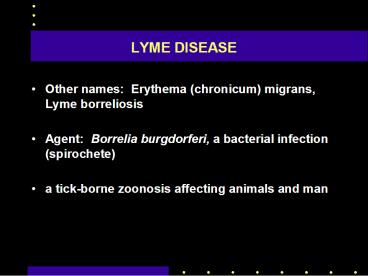LYME DISEASE - PowerPoint PPT Presentation
1 / 22
Title:
LYME DISEASE
Description:
LYME DISEASE. Microbiological features. spirochete family, related to Treponema and Leptospira ... LYME DISEASE. Epidemiology: occurrence: normally seen in the ... – PowerPoint PPT presentation
Number of Views:488
Avg rating:3.0/5.0
Title: LYME DISEASE
1
LYME DISEASE
- Other names Erythema (chronicum) migrans, Lyme
borreliosis - Agent Borrelia burgdorferi, a bacterial
infection (spirochete) - a tick-borne zoonosis affecting animals and man
2
LYME DISEASE
- Microbiological features
- spirochete family, related to Treponema and
Leptospira - fastidious
- slow growing
- periplasmic flagella associated with both shape
of organism and movement - entire genome has been sequenced
3
LYME DISEASE
- Microbiological features
- surface proteins important in detection and
vaccine development - OspA produced by spirochetes when in midgut of
tick - OspC produced upon bloodmeal (environmental
triggers in blood and temperature?) - both may be needed for effective vaccination
4
LYME DISEASE
5
LYME DISEASE
6
LYME DISEASE
- First recognized in Lyme, CT in 1975 as an
unusual occurrence of juvenile rheumatoid
arthritis - Continues to be a rapidly emerging infectious
disease - Accounts for more than 90 of all reported
vector-borne illnesses reported in the US
7
LYME DISEASE
- Epidemiology
- occurrence
- normally seen in the summer, peak in June and
July - in the US, endemic foci along the Atlantic coast
(MA to ME), upper Midwest (WI, MN), West coast
(CA, OR) - also found in Canada, Europe, Russia, Japan,
China
8
LYME DISEASE
- Epidemiology
- reservoir
- wild rodents (Peromyscus spp.)
- deer
- certain ixodid ticks through transstadial
transmission
9
LYME DISEASE
- Epidemiology
- mode of transmission
- bite of tick
- in experimental animals, transmission does not
occur until tick has been attached for at least
24 hours may be similar for humans
10
LYME DISEASE
- Epidemiology
- vector
- Ixodes scapularis (I. dammini) - East and Midwest
US - I. pacificus - West coast
- I. ricinus - Europe
- I. persulcatus - Asia
11
LYME DISEASE
- Clinical features
- humans
- early manifestations
- fatigue, fever, myalgia, headache,
lymphadenopathy, migratory arthralgia - distinctive skin lesion (EM) at site of bite
(60 of cases)
12
LYME DISEASE
- Clinical features
- later manifestations
- neurological - meningitis, cranial neuritis
including facial (Bells) palsy, ataxia,
myelitis, radiculoneuritis, encephalitis - cardiac - atrioventricular block, cardiomegaly
- articular - intermittent episodes of swelling and
pain in large joints, especially knee - both neurologic and arthritic symptoms may recur
following long periods of latency
13
LYME DISEASE
- Erythema migrans (EM)
14
LYME DISEASE
- Erythema migrans (EM)
15
LYME DISEASE
- Erythema migrans (EM)
16
LYME DISEASE
- Risk of disease by region
17
LYME DISEASE
- Clinical features
- animals
- dogs, cattle, and horses may develop systemic
disease, with articular and cardiac
mainfestations similar to that seen in humans
18
LYME DISEASE
- Diagnosis
- currently based on clinical signs supported by
serology - confirmation of some cases remains problematic
- commonly used serologic tests lack precision and
accuracy - cross-reactivity with syphilis, relapsing fever,
leptopsirosis, HIV, RMSF, infectious
mononucleosis, SLE, RA
19
LYME DISEASE
- Diagnosis
- a standardized two-test approach to serologic
testing for antibodies to B. burgdorferi - ELISA - outer surface protein Ag more sensitive
- Western blot
- IgM ELISA for early detection of Ab
- PCR, LUAT for early detection of Ag in urine
- growth on BSK from biopsy (50 of cases) to
differentiate from other Lyme-like diseases
20
LYME DISEASE
- Exposure
- peridomestic, residential
- recreational
- occupational
21
LYME DISEASE
- Prevention
- avoid tick-infested habitats
- personal protection
- periodic total body search for presence of ticks
- early removal of tick since transmission
inefficient prior to at least 24 hours
attachment - immunization - vaccines specifically for OspA and
OspC hold promise
22
LYME DISEASE
- Control
- interruption of peridomestic cycle
- tick control
- active surveillance of ticks and wildlife
- to monitor changes in the distribution
- to provide early detection
- to determine risk indices
- to provide prevalence data to evaluate
effectiveness of prevention programs































